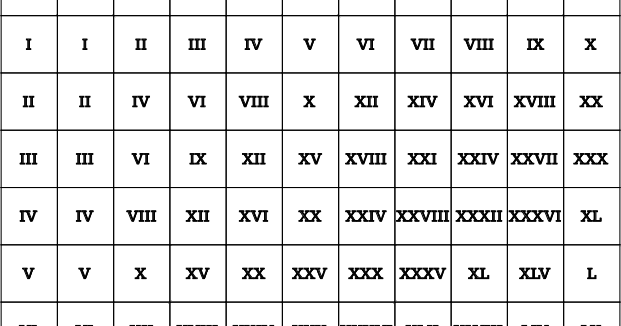Exploring Roman Numerals That Multiply to 35: A Comprehensive Guide
Roman numerals are an ancient number system that has fascinated people for centuries. This guide will explore the unique ways in which Roman numerals can be multiplied to reach the number 35. We will break down the basics of Roman numerals, delve into the multiplication process, and highlight the significance of the number 35 in both mathematics and Roman culture. Roman Numerals That Multiply to 35.
Key Takeaways
- Roman numerals originated in ancient Rome and have a rich history.
- The number 35 is represented as XXXV in Roman numerals.
- Factors of 35 include I, V, and VII, which can be combined in various ways.
- Multiplying Roman numerals can be tricky, but understanding the basics helps.
- Roman numerals are still used today in various contexts, including clocks and book chapters.
Understanding the Basics of Roman Numerals
Roman numerals are a unique way of writing numbers that originated in ancient Rome. These symbols are not just random letters; they represent specific values. The main symbols used in this system are:
| Symbol | Value |
|---|---|
| I | 1 |
| V | 5 |
| X | 10 |
| L | 50 |
| C | 100 |
| D | 500 |
| M | 1000 |
History and Origin of Roman Numerals
Roman numerals date back to around 500 BC. They were used for trade, counting, and recording events. The system was based on adding and subtracting values of symbols.
Basic Roman Numeral Symbols and Their Values
The symbols are simple, but they can combine to form larger numbers. For example:
- II = 2
- IV = 4
- IX = 9
- XL = 40
- XC = 90
How Roman Numerals Are Used Today
Today, you can find Roman numerals in various places, such as:
- Clock faces
- Movie titles
- Book chapters
Roman numerals may seem old-fashioned, but they still hold a special place in our culture and education. They help us understand the history of numbers and their evolution.
The Mathematical Concept of Multiplication in Roman Numerals
How Multiplication Works with Roman Numerals
Multiplication with Roman numerals can be tricky. Unlike our regular number system, Roman numerals do not have a symbol for zero, which makes calculations different. To multiply, you often need to break down the numbers into smaller parts. For example, to multiply XX (20) by II (2), you can think of it as adding XX two times:
- XX + XX = XL (40)
Understanding this process is key to mastering multiplication with Roman numerals.
Challenges in Multiplying Roman Numerals
There are several challenges when multiplying Roman numerals:
- No zero: This complicates calculations.
- Complex symbols: Combining symbols can be confusing.
- Lack of a standard method: Different approaches can lead to mistakes.
Examples of Simple Multiplications
Here are some simple examples of multiplying Roman numerals:
| Roman Numeral | Value | Multiplier | Result |
|---|---|---|---|
| XX | 20 | II | XL |
| III | 3 | V | XV |
| IV | 4 | VI | XXIV |
Multiplying Roman numerals requires practice and patience. By understanding the basics, you can improve your skills and avoid common mistakes.
Breaking Down the Number 35 in Roman Numerals
Representing 35 in Roman Numerals
The number 35 is represented as XXXV in Roman numerals. This is made up of three X’s (10 each) and one V (5), adding up to 35.
Factors of 35 in Roman Numerals
The prime factors of the number 35 are 5 and 7, which correspond to the Roman numerals V and VII respectively. Here’s a quick look at the factors:
| Factor | Roman Numeral |
|---|---|
| 5 | V |
| 7 | VII |
Significance of the Number 35 in Roman Culture
In Roman culture, the number 35 may not have a specific significance, but it can be broken down into its factors, which are important in understanding multiplication. Here are some points to consider:
- 35 can be seen as a product of two important numbers.
- It shows how Roman numerals can represent different values.
- Understanding these factors helps in learning multiplication with Roman numerals.
Understanding how to break down numbers like 35 into their factors is essential for mastering Roman numeral multiplication. Roman Numerals That Multiply to 35. It helps in grasping the concept of multiplication in a fun and engaging way!
Exploring Combinations That Multiply to 35
Identifying Factor Pairs in Roman Numerals
To find combinations that multiply to 35, we first need to identify their factor pairs. The factors of 35 are:
- 1 (I) and 35 (XXXV)
- 5 (V) and 7 (VII)
These pairs can be expressed in Roman numerals as follows:
| Factor 1 | Factor 2 |
|---|---|
| I | XXXV |
| V | VII |
Step-by-Step Multiplication of Factor Pairs
To multiply these factors, we can follow these steps:
- Write down the factors in Roman numerals.
- Multiply the values as you would with regular numbers.
- Convert the result back to Roman numerals if needed.
For example, multiplying V and VII gives us XXXV.
Common Mistakes to Avoid
When working with Roman numerals, it’s easy to make mistakes. Here are some common pitfalls:
- Forgetting the order of multiplication.
- Misinterpreting the values of Roman numerals.
- Confusing similar symbols, like V and X.
Understanding how to multiply Roman numerals is essential for grasping their use in mathematics. In conclusion, the number 35 can be expressed as XXXV in Roman numerals, and it multiplies with its factors in two pairs: I and XXXV; V and VII.
Practical Applications of Multiplying Roman Numerals

Using Roman Numerals in Modern Calculations
Roman numerals are not just a thing of the past; they still have real-world uses today. Here are some areas where they are applied:
- Clock faces: Many clocks use Roman numerals to show time.
- Book chapters: Some books use them for chapter numbers.
- Events: Major events like the Olympics often use Roman numerals for their editions.
Educational Benefits of Learning Roman Numeral Multiplication
Learning how to multiply with Roman numerals can be beneficial for students. Here are a few reasons:
- Enhances problem-solving skills: It encourages logical thinking.
- Cultural knowledge: It helps understand history and culture.
- Math foundation: It strengthens basic math skills.
Fun Activities Involving Roman Numerals
Engaging with Roman numerals can be fun! Here are some activities:
- Create a Roman numeral clock: Make a clock using Roman numerals.
- Roman numeral scavenger hunt: Find items labeled with Roman numerals.
- Games: Play games that involve converting numbers to Roman numerals.
Understanding how to multiply Roman numerals can help students appreciate their historical significance. This knowledge reflects Roman understanding of multiplication and exponential growth, used in practical applications such as land surveying and commerce, contributing to the development of mathematics as we know it today.
Advanced Techniques for Roman Numeral Multiplication
Tools and Resources for Learning
To effectively learn how to multiply using Roman numerals, consider the following resources:
- Online tutorials: Websites that offer step-by-step guides.
- Educational apps: Interactive applications that make learning fun.
- Books: Texts that explain the history and methods of Roman numeral multiplication.
Teaching Roman Numeral Multiplication in Schools
When teaching students about Roman numerals, it’s important to use engaging methods. Here are some effective strategies:
- Visual aids: Use charts and diagrams to illustrate concepts.
- Group activities: Encourage teamwork through fun multiplication games.
- Real-life examples: Show how Roman numerals are used in clocks and movie titles.
Incorporating Technology in Learning Roman Numerals
Technology can enhance the learning experience. Here are some ways to incorporate it:
- Interactive whiteboards: For displaying problems and solutions.
- Online quizzes: To test knowledge in a fun way.
- Video lessons: To provide visual explanations of complex topics.
Learning Roman numerals can be fun and engaging! By using various tools and methods, students can grasp the concept of multiplication in a way that sticks with them.
In summary, using a mix of tools, teaching methods, and technology can greatly improve the understanding of Roman numeral multiplication. Understanding the basics is crucial, and with the right approach, students can master this ancient numbering system.
Cultural Impact of Roman Numerals in Mathematics

Influence on Modern Number Systems
Roman numerals have had a lasting effect on how we understand numbers today. They introduced concepts that are still relevant, such as the idea of using symbols to represent values. This system was practical for the Romans, making it easier for them to conduct trade and manage their empire. Here are some key influences:
- The use of symbols for counting.
- The concept of place value, though not as developed as in modern systems.
- The idea of combining symbols to create larger numbers.
Roman Numerals in Historical Texts
Throughout history, many important documents and texts have used Roman numerals. These include:
- Ancient manuscripts.
- Legal documents from the Roman Empire.
- Historical records and timelines.
Legacy of Roman Numerals in Education
Even today, Roman numerals are taught in schools. They help students understand the history of mathematics and develop their number skills. Learning about Roman numerals can also be fun and engaging. Here are some educational benefits:
- Enhances understanding of number systems.
- Encourages critical thinking through problem-solving.
- Provides a historical context for mathematics.
Roman numerals are not just a relic of the past; they continue to influence how we learn and understand numbers today.
Overall, the cultural impact of Roman numerals is significant, shaping both historical and modern mathematics.
Roman numerals have played a big role in shaping how we think about numbers and math. They were used in ancient times and still show up in things like clocks and movie titles today. Understanding their impact can help us appreciate the history of mathematics. If you want to learn more about this fascinating topic, visit our website for more insights!
Conclusion
In summary, understanding Roman numerals that multiply by 35 can be both fun and educational. We explored how these ancient symbols work and discovered the different pairs that can create the number 35. By learning about these combinations, we appreciate the history of numbers and improve our math skills. Whether you’re a student or just curious, knowing about Roman numerals adds a unique twist to your knowledge. Keep exploring and enjoy the journey through numbers!
Frequently Asked Questions
What are Roman numerals?
Roman numerals are a number system used in ancient Rome. They use letters from the Latin alphabet to represent numbers. For example, ‘I’ stands for 1, ‘V’ stands for 5, and ‘X’ stands for 10.
How do you multiply Roman numerals?
To multiply Roman numerals, you first convert them to regular numbers, do the multiplication, and then convert the result back to Roman numerals.
What is the Roman numeral for 35?
The Roman numeral for 35 is ‘XXXV’. It is made up of three ‘X’s, which equals 30, and one ‘V’, which equals 5.
Can you give examples of pairs that multiply by 35 in Roman numerals?
Sure! The pairs that multiply to 35 are: ‘VII’ (7) and ‘X’ (5), ‘V’ (5) and ‘VII’ (7), and ‘I’ (1) and ‘XXXV’ (35).
What are some common mistakes when working with Roman numerals?
Some common mistakes include forgetting to convert the numerals to regular numbers before multiplying, mixing up the symbols, or not knowing how to write the result back in Roman numerals.






